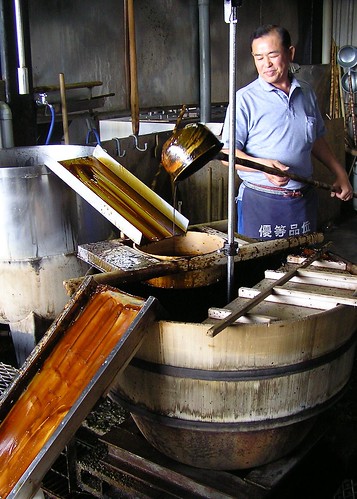
Day seventy-three: Wasambon
Okada Seitō-Sho, ¥2730/kg
A few years ago I cut out sugar as part of an extensive elimination diet. It was a rough couple of months; I missed coffee and dairy and booze, but I longed for sugar. In the end, however, the much-anticipated reunion was more slap in the face than comforting embrace: with the first bite I felt a rush of heat as an army of needles tattooed across my tongue, leaving a searing sweetness in their wake. I had forgotten what rough stuff refined white sugar can be.
If only I could afford to upgrade to wasambon, the semi-refined, hand-powdered sugar made in Japan from special Chinese sugarcane. While it may not be any healthier than the white stuff, it is certainly a better sensory experience, a prismatic sweetness that blooms across the tongue, like a slow unfurling of velvety-soft petals. It's the most expensive sugar in the world, and deservedly so. Wasambon's sole producer is Okada Seitō-Sho, based on a centuries-old farm compound outside Tokushima city on the the island of Shikoku.
My visit today coincided with the absolute slowest time of year at the Okada plant. Things don't really get going until December, when the cane grown for the factory by area farmers reaches maturity. Seasonal workers pull the canes up by hand, protecting the section around the soil line where the sugar is most concentrated. Back at Okada, the cane is crushed in huge presses. The juice that runs off is heated, purified, and allowed to crystallize very slowly; these crystals will become wasambon. The word wasambon denotes the minimum number of times (three, san) the sugar mass is wetted, kneaded by hand, wrapped in cotton, and drained under weights on a wooden tray (bon) to release the molasses; these days the process is usually repeated 4 or even 5 times to achieve a whiter product more acceptable to consumers and confectioners accustomed to refined white sugar. There are two workers experienced enough to transform the crystallized cane juice into pure, powdered wasambon, and one of them is in his late eighties.
It was a sleepy day at Okada, the countryside still bristling here and there with small patches of delicate cane swaying in the hazy late-summer sun. Since most of the workers were off for the season, the company president was kind enough to tell me a little about Okada's history and take me on a brief tour. The only worker in the cavernous factory was processing a batch of molasses (below left), and the odor wafting from the small vats gave me some notion of the sweet, buttery perfume that must suffuse the whole valley come wasambon time. In an adjacent room, a half dozen women (below right) packed pure wasambon into carved wooden molds (kashigata) to produce small higashi (above); although many higashi are made of a mixture of sugar and some firmer, whiter (and cheaper) starch, these golden nuggets of pure wasambon melt in the mouth with a lavish sweetness and no trace of grit.
Although the factory is a long, expensive taxi ride from the the nearest station, Okada also maintains a small, elegant shop in central Tokushima. Staffed by a pair of jovial and very helpful women, the shop sells Okada's higashi by the bag or box, and wasambon by the kilo.





2 comments:
Hi, just wondering if there is a place you know of that could supply/ship higashi to the UK? I am looking for a supplier.
Hi Carolyn,
Since I always hoard higashi when I find them, I've never ordered online. I did spot this site though: http://teadogu.com/edibles.html. And I bet the Urasenke tea school in London would tell you where they get their higashi from.
Good luck!
Julia
Post a Comment